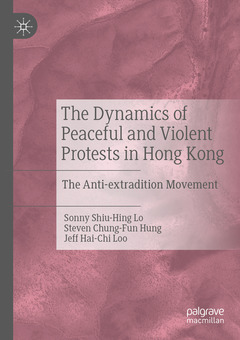The Dynamics of Peaceful and Violent Protests in Hong Kong, 1st ed. 2021 The Anti-extradition Movement
Auteurs : Lo Sonny Shiu-Hing, Hung Steven Chung-Fun, Loo Jeff Hai-Chi

This book shows that Hong Kong?s protests from June to December 2019 originated from not only an attempt to extradite a Hong Kong man involved in a Taiwan murder case, but also China?s effort at extraditing corrupt mainlanders who laundered dirty money in the territory. The mixture of peaceful and violent protests was due to the snowballing effect of protestors-police confrontations, the imbalanced way in which police exercised their power, and protestors? strategies. The protests triggered the national security concerns of Beijing, which mobilized the People?s Armed Police to Shenzhen as a warning rather than sending them openly to Hong Kong to avoid undermining the image of ?one country, two systems.? The entire debate raised the concerns of Washington, Taiwan, and foreign governments, heightening Beijing?s sensitivity. After the bill was withdrawn, the anti-extradition movement has become anti-police and anti-mainland, constantly challenging the legitimacy of the Hong Kong government and Beijing. This is a valuable read for China watchers, political scientists and all those interested in the future of East Asia.
(1) Introduction: Protests, Violence and Outcomes (it will focus on how protests evolve into violence and then affect outcomes, both policy outcomes and electoral outcomes, focusing on the election result of the November 2019 District Council elections);
(2) Chapter One: The Anti-Extradition Movement From Peaceful Protests to Violent Confrontations (We will first talk about the content of the extradition bill and discuss the opposition to it. See the attached chapter that we write but we will add the footnotes and bibliography later);
(3) Chapter 3: The First Phase of the Peaceful Protests in early June and the Lennon Wall (it will analyse the peaceful protests, their participants, their demands and responses from the government and the ordinary citizens);
(4) Chapter 4: The Second Phase of Violent Protests from June 12 onwards (it will examine all the violent protests after June 12 and explore their participants, demands and responses from the government and also Beijing);(5) The Police Handling of the Protests from Peace to Violence and Arrests (it will focus on how the police deal with the various protests, leading to violence and arrests and prosecutions);
(6) The Yuen Long Terrorist Attacks by Triads on July 21 (this Chapter will focus on the dynamics of triads involvement in this important attack on the passengers of the Yuen Long railway station, the reactions from the members of the public, the involvement of legislator Junius Ho, the role of triads, and the problematic responses from the police force);(7) The Politics of Setting up an Independent Commission of Inquiry (this chapter will focus on the political wrangling over the setting up of an independent commission, with the police opposing it and the society supporting it);
(8) The Electoral Outcome in November 2019 District Council Elections (this chapter will analyse the election results in November 2019 District Council elections, focusing on the struggles between the pan-democratic camp and the pro-government camp);
(9) Beijing’s Responses and the role of Cliques, Princeling and the Military (the reviewer suggests nicely that Beijing’s responses and their princeling, factions (Jiang Zemin and Xi Jinping) as well as military should be analyzed and we are delighted to incorporate this important point, and we will analyze whether the Hong Kong crisis may have impacts on Beijing’s domestic politics.
(10) The Anti-Extradition Movement in the Context of US-China Relations (as suggested by the reviewer, we will also add this important chapter to analyze the importance of the anti-extradition movement in the context of Sino-American relations, and also assess critically whether US, as the pro-Beijing Hong Kong media argued and alleged, did influence the pro-democracy activists and protestors).
(11) The Impacts on “One Country, Two Systems” with implications for Taiwan (this chapter will study how Taiwan has been reacting to the Hong Kong disturbances and whether the “one country, two systems” idea can really be implemented to win the hearts and minds of the people of not only Hong Kong but also Taiwan.Sonny Shiu-Hing Lo is Professor at HKU SPACE, Hong Kong. He was President of the Hong Kong Political Science Association from 2014 to 2018.
Steven Chung-Fun Hung is Assistant Professor at the Education University of Hong Kong and his research focuses on Hong Kong’s education, politics, and cultural history.
Jeff Hai-Chi Loo is a doctoral student at University of Waterloo, Canada, and his research interests include populism, social movement, Taiwan and Hong Kong politics.
Offers a political-science driven look at the Hong Kong protests of 2019
Explores what the implications of the protests could have for greater China, notably with respect to Taiwan and the US-China trade war
Provides a crucial history of the largest political disturbance in greater China since 1989
Date de parution : 10-2021
Ouvrage de 383 p.
14.8x21 cm
Date de parution : 09-2020
Ouvrage de 383 p.
14.8x21 cm



